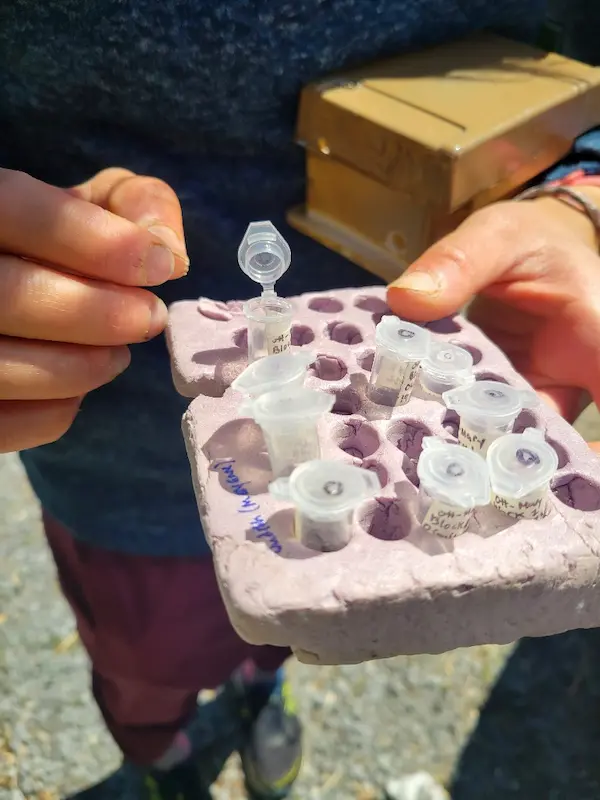Your cart is currently empty!
Cucumber Companion Plant and Canned Salsa
I like growing cosmos as a cucumber companion plant. The orange cosmos in particular I found seems to be a real bee magnet.
Your cart is currently empty!
Photo:
Photo of Lydia holding a baby mason bee, by Judith
Bees released from their cocoons seemed very attracted to the sweet-smelling lilacs, and there were primulas and tulips nearby. One of the most wonderful things I discovered when I started studying pollinators was that butterflies and moths love heavily scented plants.
Greetings fellow gardeners
It has been an interesting few days. Rain and sun and frost and cold and heat. Take your pick. I had a busy weekend at a craft sale; on Saturday I was dealing with rain and cold, and the next day had wonderful sunshine and heat.
I have waited to put my tomatoes out to harden off. I think a couple more days inside will be better. This weekend the tomatoes will go into a sheltered spot for about a week. Heritage tomatoes are like princesses and need to be handled with care. I will get the pots filled and everything prepared.
As I went about my morning chores, an amazing scent floated across to me. It was the blossoms on my crab apple tree. While all the crab apple trees in my garden have a lovely scent, the tree with the dark leaves and wine-coloured blossoms has a huge scent that wraps itself around me and won’t let go. The apples are tiny and a deep burgundy-red and make delicious jelly. Lately I have not picked the little apples as the birds seem to be very fond of them. It looks like there may be a higher yield this year, so perhaps I will get a batch in the fall.

As I puttered about on the holiday Monday, my favourite PhD student Lydia Wong came by to release the baby bees that came from my garden. The first group were the mason bees. They were stirring from their cocoons, and we released each one to fly onto the flowers. The bees were inside little containers where they had been placed after being weighed and measured at the lab. They seemed very attracted to the sweet-smelling lilacs, and there were primulas and tulips nearby.

It is really special to hold little baby bees as they leave their cocoons. All the other babies were still sleeping; leaf-cutting bees and grass-carrying wasps and others.
One of the most wonderful things I discovered when I started studying pollinators was that butterflies and moths love heavily scented plants. As I go wandering out to the road to check the mailbox, I pass my common lilac. These purple blooms have a very heavenly scent that is a way of assuring the world that spring is actually here. My lilac is old and twisted and has many blooms. I have to be careful with it however as I find that if the branches grow too close together, I get powdery mildew. If I make sure it has good airflow, I do not have mildew. If I were not so busy, I would be picking those blossoms for lilac jelly. Hopefully I can get some rose petal jelly made this year.

I have found that it is a busy year for mosquitoes. Fortunately, the birds are busily eating them, and they should be lessening soon. I like to open up the gazebo so the too-many cats can enjoy the fresh air, but I am not crazy about inviting the mosquitoes to join. Enjoy your week. Judith. (Email: sghorticultural@gmail.com) Veggie Bites are available at https://sghorticultural.wixsite.com/website or https://gardeningcalendar.ca/category/veggie-bites/
I like growing cosmos as a cucumber companion plant. The orange cosmos in particular I found seems to be a real bee magnet.
Jasmine Plant has become popular as a container plant for a sheltered setting. Come learn how to care and propagate the Jasmine Plant!
Find the perfect trellis plants to add color and beauty to your garden. Explore a variety of options and get creative with different trellis designs. Learn more now!
Learn how to care for your Preston Lilac. Tips on planting, soil, watering, pruning, and more for a thriving garden addition.
Discover the real story behind earwigs – beneficial insects often misunderstood in gardens. Learn how to control and trap earwigs effectively.
Learn about a variety of acid loving plants that add beauty to your garden. From azaleas to hydrangeas, unlock a colorful world of gardening possibilities.
GardeningCalendar.ca gets some funding from advertisers. If you click on links and advertisements at no cost to you, the site may receive a small commission that helps fund its operation.
© 2025 J&S Calendars Ltd.
Leave a Reply
You must be logged in to post a comment.